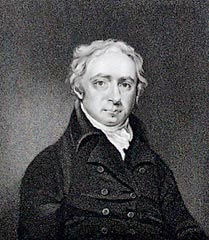Restoration of Malmesbury Abbey
William Lisle Bowles
Monastic and time-consecrated fane!
Thou hast put on thy shapely state again,
Almost august as in thy early day,
Ere ruthless Henry rent thy pomp away.
No more the mass on holidays is sung,
The Host high raised or fuming censer swung;
No more, in amice white, the Fathers slow
With lighted tapers in long order go;
Yet the tall window lifts its arched height,
As to admit heaven's pale but purer light;
Those massy clustered columns, whose long rows,
Even at noonday, in shadowy pomp repose
Amid the silent sanctity of death,
Like giants seem to guard the dust beneath.
Those roofs re-echo (though no altars blaze)
The prayer of penitence, the hymn of praise;
Whilst meek religion's self, as with a smile,
Reprints the tracery of the holy pile,
Worthy its guest, the temple. What remains?
O mightiest Master! thy immortal strains
These roofs demand; listen! with prelude slow,
Solemnly sweet, yet full, the organs blow.
And hark! again, heard ye the choral chant
Peal through the echoing arches, jubilant?
More softly now, imploring litanies,
Wafted to heaven, and mingling with the sighs
Of penitence, from yonder altar rise;
Again the vaulted roof "Hosannahs" rings,—
"Hosannah! Lord of lords, and King of kings!"
Rent, but not prostrate; stricken, yet sublime;
Reckless alike of injuries or time;
Thou, unsubdued in silent majesty,
The tempest hast defied, and shalt defy!
The temple of our Sion so shall mock
The muttering stomi, the veiy earthquake's shock,
Founded, O Christ, on thy eternal rock!
Malmesbury Abbey was once one of the richest in England. It was founded in the 7th century by St Aldhelm and the great gothic building which you can still see was begun in 1180. Malmesbury was famous for its spire, which was even taller than Salisbury Cathedral (it fell down in the 16th century) and for its library, one of the largest in Europe.
Malmesbury was the abbey of the Medieval historian William of Malmesbury, and of the inventive monk Eilmer, who in 1010 made an early attempt at human flight. He built a glider and jumped off the abbey tower. He flew more than 200 yards before he crashed. He blamed his crash on the lack of a tail for his glider.
The "ruthless Henry" of the poem is of course Henry VIII, who dissolved the monasteries, including Malmesbury. After the dissolution, part of the Abbey church was rescued and restored for worship, which continues to this day.
The ruins of the Abbey are impressive and the surrounding gardens going down to the river are also beautiful to visit.
